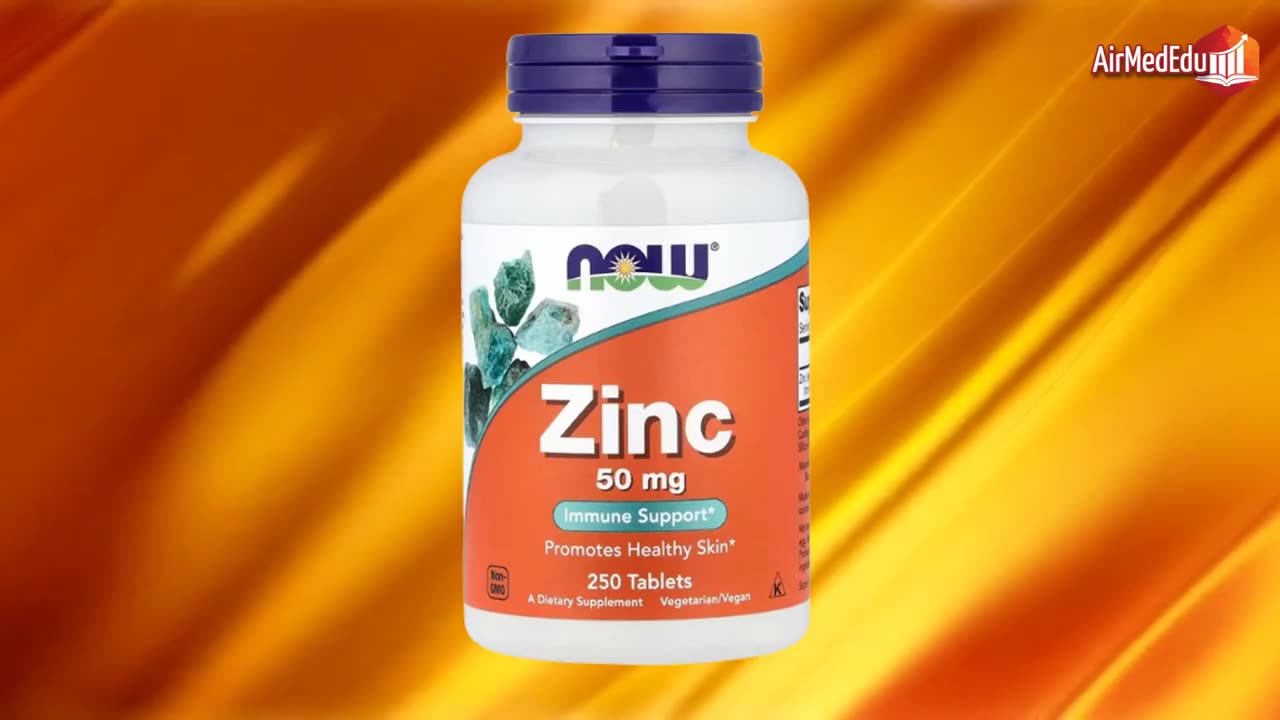Premium Only Content

Effect of Zinc on the Body
Zinc is an essential mineral that plays a fundamental role in the functioning of the human body, acting as a key component in more than 300 enzymes and participating in vital processes such as protein synthesis, cell division, and immune response. Present in every cell of the body, zinc is not stored in large quantities and must therefore be obtained daily through diet or supplements. The body's total zinc intake is approximately 1.5 grams in women and 2.5 grams in men, mostly in skeletal muscles and bones. Its action in the body goes beyond the basics, as it regulates genetic expression through thousands of zinc-dependent transcription factors, facilitates wound healing by promoting keratinocyte migration, and protects against oxidative stress thanks to its role in antioxidant proteins such as metallothioneins. Furthermore, zinc modulates ion secretion in the intestine, making it effective against diarrhea, and improves insulin action, contributing to carbohydrate metabolism and potentially glucose control in people with diabetes.
In the immune system, zinc is essential for the development and function of cells such as lymphocytes and neutrophils, helping to reduce inflammation and fight infections by inhibiting viral and bacterial replication. Deficiency can disrupt these mechanisms, leading to increased susceptibility to disease, while adequate levels maintain skin integrity, the sense of taste and smell, and support growth during critical stages such as pregnancy, childhood, and adolescence. For example, during pregnancy, zinc ensures proper fetal development, preventing complications such as low birth weight, and in children, it accelerates recovery from respiratory and diarrheal infections in regions where deficiency is common.
Zinc's effects extend to cellular metabolism, where it acts as a cofactor in enzymes that break down carbohydrates and synthesize DNA and proteins, which is crucial for tissue repair and the prevention of oxidative damage that could lead to chronic diseases. In the gastrointestinal tract, zinc regulates absorption and excretion to maintain homeostatic balance, increasing absorption when intake is low and decreasing it when intake is excessive to avoid toxicity. This adaptability makes zinc vital in contexts of malnutrition, where its absence causes symptoms such as alopecia, growth retardation, and immunological weakness, affecting multiple systems such as the digestive, reproductive, and central nervous systems.
Turning to its benefits, zinc is notable for strengthening the immune system, reducing the duration of the common cold by up to 33% when taken in doses of 80 to 92 milligrams per day in the form of pills or syrup at the onset of symptoms, although it does not always affect their severity. In children in developing countries, supplementation with 10 to 20 milligrams daily for up to 20 months reduces the incidence of pneumonia and diarrhea, shortening the duration of the latter by half a day in infants older than six months. This has led to WHO recommendations of 20 milligrams daily for 10 to 14 days to treat acute diarrhea in areas of deficiency.
Another notable benefit is in wound healing, where zinc accelerates collagen synthesis and the inflammatory response, being especially useful in diabetic ulcers with doses of 50 milligrams daily, or in pressure ulcers in people with deficiency. For age-related macular degeneration, combined with antioxidants, 80 milligrams daily reduces the risk of progression by 25% in high-risk individuals, protecting the retina from cellular damage. In type 2 diabetes, observational studies indicate a 13% lower risk with high intakes, and supplementation of 4 to 150 milligrams improves glycemic control, lipid profiles, and insulin resistance, although it does not conclusively prevent the disease.
Zinc also offers benefits for skin health, treating acne by reducing inflammation, inhibiting bacteria such as P. acnes, and regulating sebum production, both in topical and oral applications. It reduces oxidative stress and chronic inflammation, with 45 milligrams per day lowering inflammatory markers in older adults, potentially decreasing the risk of age-related diseases such as infections and cancer. In children with HIV, it can reduce immune failure events and diarrhea rates, while in low-income pregnancies, it prevents childhood and maternal morbidity. Additionally, it benefits conditions such as bad breath, cold sores, gingivitis, and warts, and in Wilson's disease, it blocks copper absorption to manage excess copper in the liver.
In terms of child growth, zinc supplementation promotes linear and weight gain in deficient children, addressing the growth retardation that affects millions in developing countries, where zinc deficiency causes more than 450,000 annual deaths in children under five years of age due to infections. For depression, it may enhance antidepressant effects, and in schizophrenia and multiple sclerosis, there are emerging correlations, although more research is needed. In sepsis, zinc redistribution affects outcomes, and in metabolic syndrome, it improves blood pressure, glucose, and LDL cholesterol.
Regarding dosages, dietary recommendations vary by age, sex, and life stage, with the recommended daily intake for adults being 11 milligrams for men and 8 for women over 19 years of age, increasing to 11 during pregnancy and 12 during breastfeeding. For children, it ranges from 2 milligrams for infants 0 to 6 months of age to 8 for those 9 to 13 years of age, and up to 11 for adolescent males. These amounts are based on maintaining 97-98% of the needs of healthy individuals and can be obtained from foods such as oysters (up to 32 milligrams per 3 ounces), beef, seafood, legumes, nuts, whole grains, dairy products, and eggs, although absorption is better in animal products than in plant-based foods due to inhibitors such as phytates.
The tolerable upper limit is 40 milligrams per day for adults, dropping to 34 in adolescents aged 14 to 18 years, and even lower in young children, such as 7 milligrams for ages 1 to 3. Exceeding these limits does not apply to supervised medical treatments, but in general, it is recommended not to exceed them to avoid interference with other minerals. For supplements, forms such as zinc citrate or gluconate are better absorbed than the oxide, and vegans or people with absorption problems (such as gastrointestinal diseases) may need up to 50% more. For specific treatments, such as colds, doses above 75 milligrams are more effective, but only in the short term.
However, zinc is not without side effects, especially at high doses, where it can cause nausea, vomiting, diarrhea, abdominal cramps, and headaches, symptoms that usually appear within 3 to 10 hours and resolve quickly. Long-term, intakes above 40 milligrams daily reduce copper absorption, leading to deficiency that affects the nervous system with numbness and weakness in the extremities. Other effects include stomach upset, dizziness, and, with nasal applications, permanent loss of smell, so intranasal use is not recommended.
Zinc toxicity, although rare due to its relative nontoxicity, manifests as fatigue, lethargy, epigastric pain, and, in extreme doses of 10 to 30 grams, can be fatal. Chronic excess interferes with iron and copper, causing anemia or deficiencies, and topical supplements on broken skin cause burning, itching, or tingling. In children, high doses for diarrhea can induce vomiting, so smaller amounts such as 5 to 10 milligrams are preferred.
To avoid complications, it is essential to consult a healthcare professional before supplementing, especially in children, pregnant or breastfeeding women, or people with preexisting conditions such as malabsorption or the use of diuretics that increase zinc loss. Monitoring interactions is key: zinc reduces the effectiveness of antibiotics such as quinolones or tetracyclines, so it should be taken 2 hours before or 4-6 hours after; with penicillamine for arthritis, separate them by at least 1 hour; and with cisplatin or integrase inhibitors, it can alter blood levels. Avoid high doses in well-nourished children to prevent copper deficiency, and opt for varied dietary sources to cover needs safely.
At-risk groups such as vegetarians, alcoholics, the elderly, and those with genetic mutations should evaluate their intake, as deficiency affects 2 billion people globally, but unnecessary supplementation increases risks. Monitoring serum levels (normal ranges from 80-120 micrograms per deciliter) is helpful for treatment, although they do not always correlate perfectly. Finally, prioritizing a balanced diet with meat, seafood, and fortified foods minimizes supplementation needs, ensuring benefits without adverse effects.
Zinc, although modest in body quantity, profoundly influences health, from preventing infections to supporting metabolism, but its management requires balance to maximize benefits and minimize harm. In global contexts, its role in reducing infant mortality from diarrhea and pneumonia highlights its public importance, while in individuals, personalizing doses avoids toxicity. Thus, consciously integrating zinc into daily routines promotes overall well-being without unnecessary complications.
-
 LIVE
LIVE
Kim Iversen
2 hours agoWHAT?! Epstein Emails Claim Trump Did THIS To Bill Clinton...
1,211 watching -
 LIVE
LIVE
Tundra Tactical
2 hours ago🚨🚨LIVE AT 5PM CST!!!Dad Gamer Attempts To Grow Up, Fails To Accept Reality Becomes Mediocre Gamer
43 watching -
 LIVE
LIVE
EricJohnPizzaArtist
2 hours agoAwesome Sauce PIZZA ART LIVE: SKANKFEST DAY ONE!
203 watching -

vivafrei
9 hours agoAn Inconvenient Study: Live with Del Bigtree! FBI "Fast Response" Fact Checked! Megyn Kelly & MORE!
76.1K31 -
 1:35:03
1:35:03
Russell Brand
4 hours agoDemocrats Drop Epstein Emails — All About Trump - SF650
65K32 -
 LIVE
LIVE
Nerdrotic
3 hours ago $4.82 earnedBBC Crashout | Hollywood For Sale | Battle of the Blonde's | Witcher BOMBS - Friday Night Tights 380
1,350 watching -
 14:26
14:26
Upper Echelon Gamers
4 hours ago $0.39 earnedThe Carvana Scam - A Predatory BUBBLE
3.66K3 -
 LIVE
LIVE
LFA TV
21 hours agoLIVE & BREAKING NEWS! | FRIDAY 11/14/25
871 watching -
 LIVE
LIVE
Dr Disrespect
7 hours ago🔴LIVE - DR DISRESPECT - BLACK OPS 7 - LAUNCH DAY CHAMPION
1,053 watching -

StoneMountain64
5 hours agoCall of Duty Black Ops 7 Gameplay LAUNCH DAY
34.8K